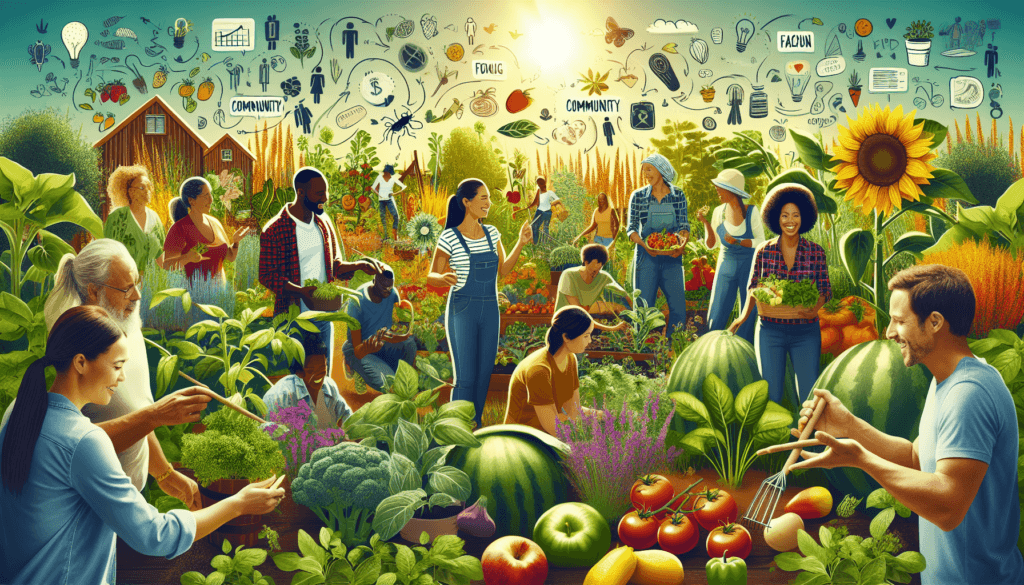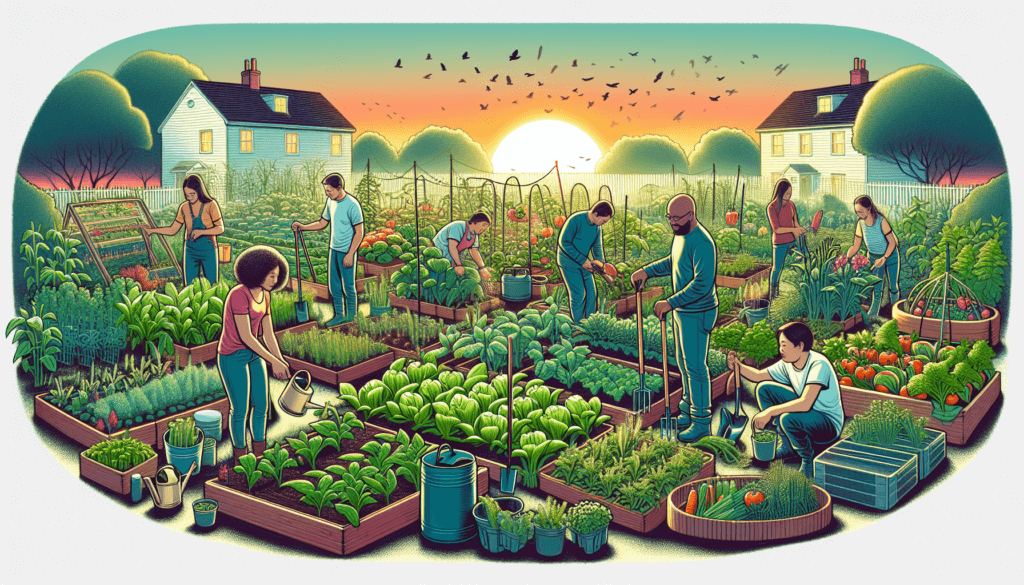Starting a community garden may seem like a daunting task, but it is actually much easier than you might think. With a little planning, dedication, and support from your neighbors, you can create a thriving green oasis right in your own neighborhood. In this article, we will explore the steps involved in starting a community garden and provide you with valuable tips and resources to help you get started. So, if you’ve been dreaming of bringing people together and greening up your community, read on to discover just how simple it can be to start a community garden. Starting a community garden can be a rewarding and fulfilling endeavor, and with some careful planning and effort, you can create a thriving green space that benefits both you and your community. In this comprehensive article, we will guide you through the various steps involved in starting a community garden, from choosing the right location to overcoming challenges and celebrating success stories. So grab your gardening gloves and let’s get started!

Choosing a Location
Access to Sunlight
One of the most critical factors to consider when choosing a location for your community garden is access to sunlight. Most plants require at least six hours of direct sunlight each day to thrive. Look for an open space that is not obstructed by tall buildings or trees that could shade the garden. Ideally, the garden should face south or southwest to maximize exposure to sunlight throughout the day. Consider the orientation of the surrounding buildings and natural landscape to ensure a well-lit garden.
Soil Quality
Another vital aspect to consider is the quality of the soil. Conduct a soil test to determine its nutrient content and pH level. Most vegetables prefer slightly acidic to neutral soil with a pH range of 6.0 to 7.5. If the existing soil is poor or contaminated, it may be necessary to amend it with organic matter, such as compost or manure, to improve its fertility. Additionally, consider the soil drainage; it should neither be too dry nor too waterlogged.
Availability of Water
Water is essential for the success of any garden, so it’s crucial to have a reliable source of water in close proximity to your chosen location. Ideally, the site should have access to a water supply, whether through a nearby faucet, irrigation system, or rainwater harvesting. Adequate water availability will ensure that your plants receive regular hydration, especially during dry spells and hot summer months. Consider the cost and feasibility of water access when selecting your garden site.
Permission and Legalities
Before embarking on your community garden project, it’s important to obtain permission from the relevant authorities or property owners. Depending on your location, you may need to acquire permits or go through a formal approval process. Check with local government departments, parks and recreation agencies, or community organizations to understand the legalities and regulations surrounding community gardens in your area. Ensuring you have the necessary permissions will help avoid potential conflicts or issues in the future.
Planning and Designing
Determining Garden Size
The size of your community garden will depend on various factors, such as the available space, the number of participants, and the intended purpose of the garden. Consider the projected number of gardeners and the types of plants you wish to grow. A smaller garden can be an excellent starting point for a close-knit community, while a larger garden can support a more extensive range of plants and activities. Balancing the garden size with the resources and expertise available will contribute to a successful and manageable project.
Layout and Pathways
An efficiently designed garden layout is crucial for maximizing space and accessibility. Plan the pathways to allow easy movement and maintenance within the garden. Consider including wider paths to accommodate wheelchair users or individuals with mobility challenges. Additionally, group plants with similar sunlight, water, or soil requirements together to optimize their growth. A well-thought-out layout will not only make the garden visually appealing but also make it easier for gardeners to navigate and tend to their plants.
Choosing Plants
When selecting plants for your community garden, consider the preferences and needs of the participating gardeners. Opt for a mix of vegetables, herbs, fruits, and flowers that are well-suited to your climate and growing conditions. Choose plants that are easy to grow and maintain, particularly if your garden involves individuals with limited gardening experience. Incorporate a variety of plant species to create a diverse and vibrant ecosystem that benefits both the garden and the local environment.
Ensuring Accessibility
To make your community garden inclusive and accessible to all members of the community, consider incorporating features that cater to individuals with different abilities. Ensure that pathways, raised beds, and seating areas are wheelchair-friendly and consider installing ramps or handrails where necessary. Provide tools and equipment that are lightweight and easy to use for individuals with physical limitations. By prioritizing accessibility, you can create a welcoming and inclusive space for everyone to enjoy.

Gathering Support
Community Engagement
One of the keys to a successful community garden is active community involvement. Engage with members of your community through outreach programs, workshops, and community meetings to generate interest and gather support. Share your vision for the community garden and the potential benefits it can bring. Encourage community members to provide input and suggestions on the garden’s design and activities. By involving the community from the planning stage, you can build a sense of ownership and foster long-term commitment.
Forming a Committee
Assembling a dedicated committee of volunteers can help distribute responsibilities and ensure smooth management of the community garden. Recruit individuals with diverse skills and interests who are passionate about gardening and community development. Assign specific roles such as garden maintenance, fundraising, event coordination, and communication to committee members. Regular meetings and open lines of communication will help build a strong and cohesive team that can effectively drive the success of the garden.
Obtaining Funding
Financial resources are often necessary to kickstart a community garden project. Seek out funding opportunities from various sources, such as local government grants, community foundations, or corporate sponsorships. Craft a compelling grant proposal outlining the goals and benefits of the garden, as well as details on how the funds will be utilized. Consider organizing fundraising events within the community to mobilize support and generate additional funds. A well-funded community garden will have the resources to invest in infrastructure, supplies, and educational programs.
Collaborating with Local Organizations
Build partnerships with local organizations, schools, businesses, and community centers to leverage their resources and expertise. Collaborate with gardening clubs, environmental organizations, or universities to provide guidance and support for your community garden. Seek opportunities for knowledge exchange, skill-building workshops, or mentorship programs. By forming meaningful partnerships, you can tap into existing networks and enhance the sustainability and impact of your community garden.
Preparing the Site
Clearing the Land
Before you can start planting, you’ll need to clear the designated garden area of any existing vegetation, debris, or obstacles. Remove weeds, grass, and rocks to create a clean slate for your garden. Consider organizing a community workday to get volunteers involved in this initial phase. Clearing the land together can foster a sense of camaraderie and shared ownership among participants. Make sure to dispose of the cleared materials responsibly, either through composting or recycling.
Building Raised Beds
Raised beds are a popular choice for community gardens, as they provide better control over soil quality and drainage. Determine the dimensions and layout of the raised beds based on the garden’s design and accessibility requirements. Use untreated lumber or rot-resistant materials to construct the frames, ensuring they are sturdy and durable. Fill the raised beds with a mixture of high-quality soil, compost, and organic matter to create a fertile growing environment for your plants. Raised beds also make gardening more comfortable and are ideal for individuals with mobility limitations.
Installing Fences and Gates
Installing a fence around your community garden offers protection and helps define the garden’s boundaries. It can serve as a deterrent to trespassers and help keep out unwanted wildlife. Choose a fence height that suits the needs of your garden, considering any potential deer or rabbit pressure. Install a gate that can be easily opened and closed, allowing authorized access for gardeners and community members. A well-designed fence will not only provide security but also contribute to the overall aesthetic appeal of the garden.
Providing Storage and Tools
Creating storage space within your community garden ensures that tools, supplies, and equipment are easily accessible and well-organized. Install sheds, cabinets, or toolboxes to store gardening tools, gloves, seeds, and other essential items. Consider labeling and categorizing items to streamline their retrieval. Encourage gardeners to share tools and resources, promoting a sense of collaboration and community spirit. Adequate storage and well-maintained tools will contribute to efficient garden management and overall productivity.

Planting and Maintenance
Sourcing Seeds and Plants
Procuring high-quality seeds and plants is essential for successful gardening. Look for local nurseries, seed exchanges, or reputable online sources that offer a wide variety of plant species suitable for your region. Consider choosing heirloom or open-pollinated seeds to promote biodiversity and preserve traditional plant varieties. Engage local gardening experts or master gardeners to provide advice on plant selection and help with identifying suitable cultivars. Encourage gardeners to save seeds from successful harvests to ensure a sustainable seed supply for future seasons.
Proper Planting Techniques
Planting your crops correctly is crucial for their growth and development. Follow the recommended planting depth and spacing guidelines provided on the seed or plant packaging. Prepare the soil by loosening it with a garden fork or tiller, removing any weeds or rocks. Create furrows or holes for planting, taking care not to damage the roots or stems of the seedlings. Gently firm the soil around the plants to eliminate air pockets. Water the newly planted crops thoroughly to help them establish their roots. Provide support structures, such as stakes or trellises, for plants that require extra support as they grow.
Watering and Irrigation
Watering your community garden properly is vital for the health and productivity of your plants. Monitor soil moisture regularly and water the plants when the top inch of soil feels dry. Water deeply and thoroughly, ensuring that the water reaches the plant’s root zone. Consider using efficient irrigation methods such as drip irrigation or soaker hoses to minimize water wastage. Mulching around the plants can help retain moisture and reduce weed growth. Encourage gardeners to adopt water-saving practices and educate them on watering techniques to promote responsible water usage.
Weeding and Pest Control
Regular weeding is necessary to minimize competition for nutrients, sunlight, and water. Encourage gardeners to regularly inspect their plots and remove weeds promptly. Together, organize weeding workdays where participants can pitch in and tackle larger areas of the garden. Implementing integrated pest management practices can help prevent and control common garden pests while minimizing the use of chemicals. Encourage gardeners to monitor their crops for signs of pest damage and adopt environmentally friendly pest control methods, such as companion planting or introducing beneficial insects.
Community Involvement
Organizing Workdays
Organizing regular workdays is a fantastic way to engage the community and maintain the garden collectively. Schedule workdays throughout the growing season for general maintenance tasks such as weeding, mulching, and pruning. Divide the tasks into smaller, manageable groups and set achievable goals for the workday. Providing refreshments and snacks can create a friendly and enjoyable atmosphere. Workdays not only ensure that necessary tasks are completed but also foster community bonding and a sense of shared accomplishment.
Educational Programs
Community gardens offer an excellent opportunity for educational programs and skill-building workshops. Organize gardening workshops, seminars, or demonstrations to educate gardeners and community members about various aspects of gardening. Invite guest speakers, master gardeners, or local experts to share their knowledge and experiences. Consider organizing hands-on sessions, where participants can learn about composting, seed-saving, or organic gardening practices. Educational programs can empower participants, improve their gardening skills, and strengthen the community’s connection with their food and the natural world.
Celebrating Harvests
Celebrating harvests is a heartwarming way to mark the successful culmination of the growing season. Organize harvest festivals, potluck dinners, or community picnics where participants can gather and share the fruits of their labor. Encourage gardeners to bring dishes prepared with their garden produce, sparking conversations about recipes and gardening experiences. Highlight the garden’s achievements and recognize the efforts of the community members who contributed to its success. Celebrations are an essential part of community building and can strengthen the bond between gardeners and their local community.
Community Events
Community gardens can serve as vibrant spaces for organizing various events that bring people together. From plant sales and workshops to art exhibitions and music performances, the possibilities are endless. Collaborate with local artists, musicians, or community organizations to create engaging events that celebrate the garden’s beauty and purpose. Invite schools, nearby residents, and other community groups to participate and experience the garden firsthand. Community events not only enhance the visibility and impact of the garden but also foster a sense of belonging and pride among participants.

Maintaining Sustainability
Composting and Recycling
Integrating composting and recycling practices into your community garden can significantly reduce waste and contribute to the garden’s sustainability. Encourage gardeners to compost kitchen scraps, garden waste, and fallen leaves to produce nutrient-rich compost. Provide designated compost bins within the garden and educate gardeners on proper composting techniques. Additionally, promote recycling by placing recycling bins for plastic bottles, cans, and other recyclable materials. Sustainability practices like composting and recycling create a closed-loop system that promotes soil health and reduces environmental impact.
Implementing Eco-friendly Practices
Promoting eco-friendly practices within your community garden aligns with sustainability goals and contributes to a healthier and more resilient environment. Encourage organic gardening practices, such as avoiding synthetic pesticides and herbicides, and promoting natural pest control methods. Incorporate pollinator-friendly plants to support local bee populations and enhance biodiversity. Minimize the use of plastic by opting for biodegradable or reusable materials whenever possible. Strive to minimize your garden’s carbon footprint by reducing energy consumption, conserving resources, and adopting renewable energy sources.
Conserving Water
Water conservation is a significant aspect of sustainability in gardening. Encourage water-saving practices such as mulching, which helps retain moisture in the soil, reducing the need for frequent watering. Consider installing rainwater harvesting systems to collect and store rainwater for use in the garden. Educate gardeners on the importance of water conservation and provide tips on efficient irrigation methods. By conserving water, you not only reduce your garden’s environmental impact but also set an example for the community in embracing sustainable practices.
Promoting Biodiversity
Community gardens can play a crucial role in promoting biodiversity in urban areas. Incorporate native plants into your garden design, as they are well-adapted to the local climate and provide habitat for local wildlife. Create areas for pollinators and beneficial insects by planting a diverse range of flowers and herbs. Avoid using pesticides that harm beneficial insects and instead encourage natural pest control methods. By fostering biodiversity, your community garden becomes an ecosystem that supports a wide array of plant and animal life, contributing to the overall health of the environment.
Overcoming Challenges
Securing Long-term Support
Ensuring the long-term sustainability and success of a community garden often involves overcoming various challenges. One of these challenges is securing ongoing support from community members, volunteers, and stakeholders. Continuously communicate the benefits and achievements of the garden to keep participants engaged and motivated. Develop a clear vision and mission for the garden and regularly assess and adjust your goals accordingly. Cultivate strong relationships with local government officials, community groups, and businesses that can provide ongoing support and resources.
Addressing Conflicts
In any community endeavor, conflicts may arise due to differences in opinions, competing interests, or challenges in communication. It is essential to establish a conflict resolution process and encourage open and respectful dialogue among gardeners and community members. Create spaces for discussions and actively listen to different perspectives. Facilitate mediation or bring in a neutral third party to help resolve conflicts when necessary. By actively addressing conflicts, you can maintain a harmonious and inclusive environment within your community garden.
Dealing with Vandalism or Theft
Unfortunately, vandalism or theft can occasionally occur in community gardens. Take preventive measures by installing secure fencing and gates, as well as adequate lighting in the garden. Encourage all gardeners to be vigilant and report any suspicious activities. Consider organizing neighborhood watch programs or encouraging gardeners to keep an eye out for each other’s plots. Fostering a strong sense of community and a safe environment can act as deterrents and reduce the likelihood of such incidents.
Managing Time and Resources
Community garden projects require effective management of time and resources to ensure their sustainability. Encourage gardeners to develop a planting and maintenance schedule, considering the specific needs of the crops and the available resources. Set realistic goals and prioritize tasks to make efficient use of limited time and resources. Keep track of expenses, volunteer hours, and garden activities to evaluate the effectiveness of your management strategies. Regularly assess and adjust your plans based on the input and feedback from gardeners and community members.

Benefits of Community Gardens
Improved Nutrition
Community gardens can significantly contribute to improving nutrition within the local community. By growing fresh produce locally, community gardeners have immediate access to nutritious fruits and vegetables. This direct connection to the source of their food helps increase consumption of healthy, homegrown produce, thereby improving overall nutrition. Sharing garden surplus with local food banks and community organizations allows individuals with limited resources to access fresh, nutritious food as well.
Enhanced Food Security
Community gardens enhance food security by increasing local food production and reducing dependence on distant food sources. By growing food locally, community gardeners contribute to a more resilient and self-sufficient food system. The availability of fresh produce within the community reduces transportation emissions and the environmental impact associated with long-distance food distribution. Community gardens also serve as educational spaces where participants learn about sustainable practices and gain skills for growing their own food, further enhancing food security.
Social Interaction and Cohesion
Community gardens act as social hubs, bringing people of diverse backgrounds and ages together. By working side by side in the garden, participants engage in meaningful social interactions and develop relationships with their neighbors. Sharing gardening tips, exchanging recipes, and celebrating harvests fosters a sense of belonging and strengthens community bonds. Community gardens are inclusive spaces that provide opportunities for individuals from various cultures and generations to come together and create a supportive and cohesive community.
Environmental Benefits
Community gardens have numerous environmental benefits, making them vital components of sustainable urban environments. The presence of green spaces helps improve air quality by absorbing pollutants and reducing heat island effects. Community gardens also contribute to carbon sequestration, helping mitigate climate change. The inclusion of native plants and practices that promote biodiversity supports local ecosystems and enhances habitat for birds, butterflies, and other wildlife. By reconnecting people with nature, community gardens foster environmental stewardship and promote a more sustainable way of life.
Success Stories
Case Studies of Thriving Community Gardens
To inspire and motivate you on your community garden journey, let’s look at a couple of success stories from thriving community gardens around the world.
1. The Three Sisters Garden – Denver, Colorado, USA
The Three Sisters Garden in Denver is a shining example of a community garden that combines traditional Native American agricultural practices with modern urban gardening techniques. The garden showcases three crops – corn, beans, and squash – that are interplanted in a symbiotic relationship. The corn provides support for the climbing beans, while the squash acts as a living mulch, suppressing weeds and conserving soil moisture. The garden not only promotes sustainable agriculture but also serves as an educational and cultural space for the diverse community.
2. Guerilla Gardening – London, United Kingdom
Guerilla gardening initiatives in London have transformed abandoned and neglected spaces, including disused lots, road medians, and even rooftops, into vibrant community gardens. These guerrilla gardens are created by dedicated local volunteers who repurpose these spaces to grow flowers, herbs, and vegetables. By reclaiming unused urban land, these initiatives contribute to urban beautification, food production, and community engagement. The guerilla gardens serve as reminders of the power of grassroots initiatives and the impact that dedicated individuals can have on their communities.
In conclusion, starting a community garden may not be without its challenges, but the rewards far outweigh the initial efforts. By carefully selecting a suitable location, planning and designing the garden, gathering community support, preparing the site, and implementing proper planting and maintenance practices, you can create a thriving community space. Community involvement, sustainability practices, addressing challenges, and acknowledging the benefits of community gardens will further enhance the success of your project. So, get ready to sow the seeds of community bonding, food security, and environmental stewardship as you embark on your community garden journey. Remember, the possibilities are endless, and your community garden can be a source of inspiration and joy for years to come.


